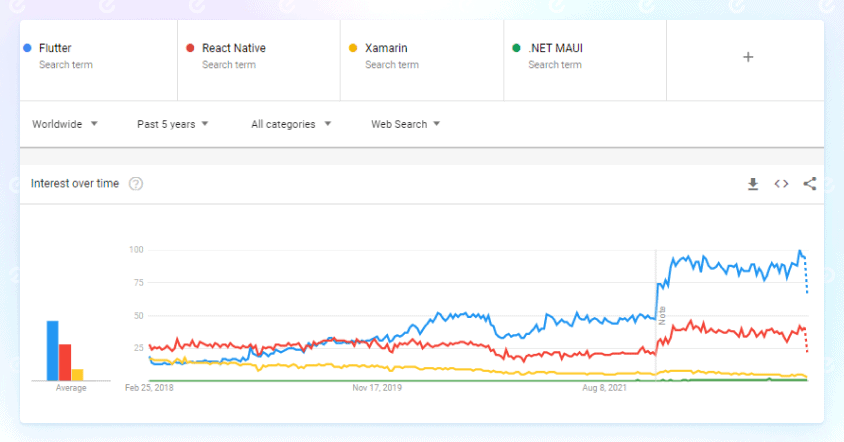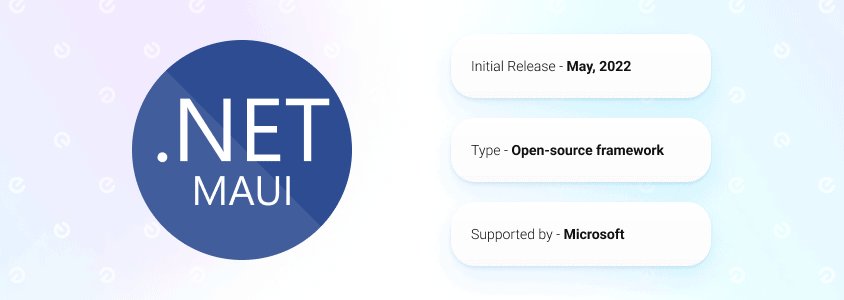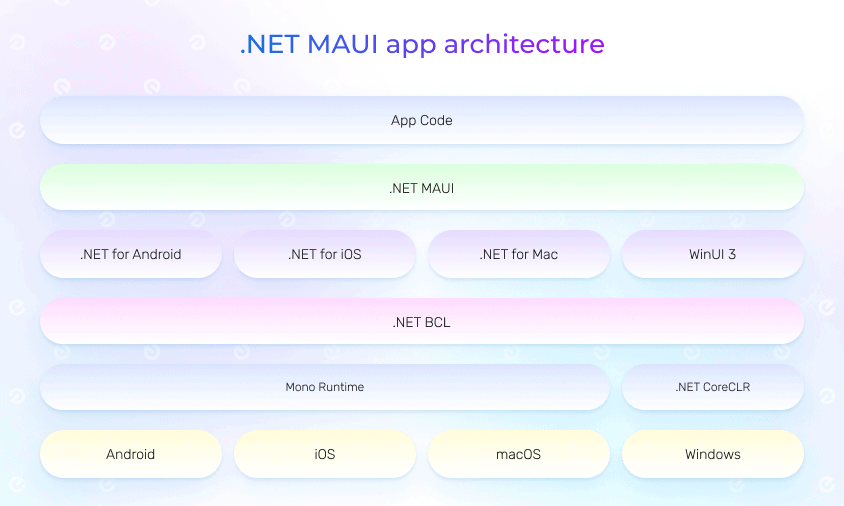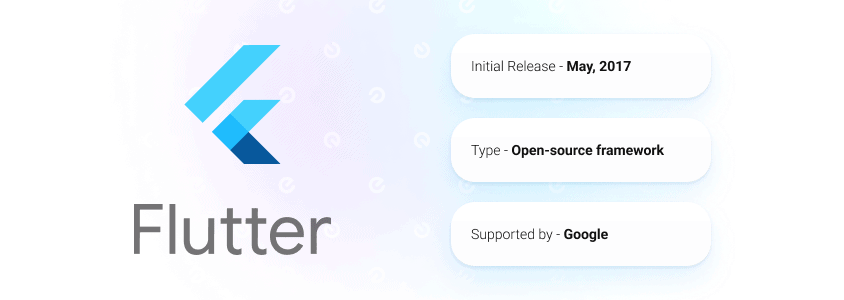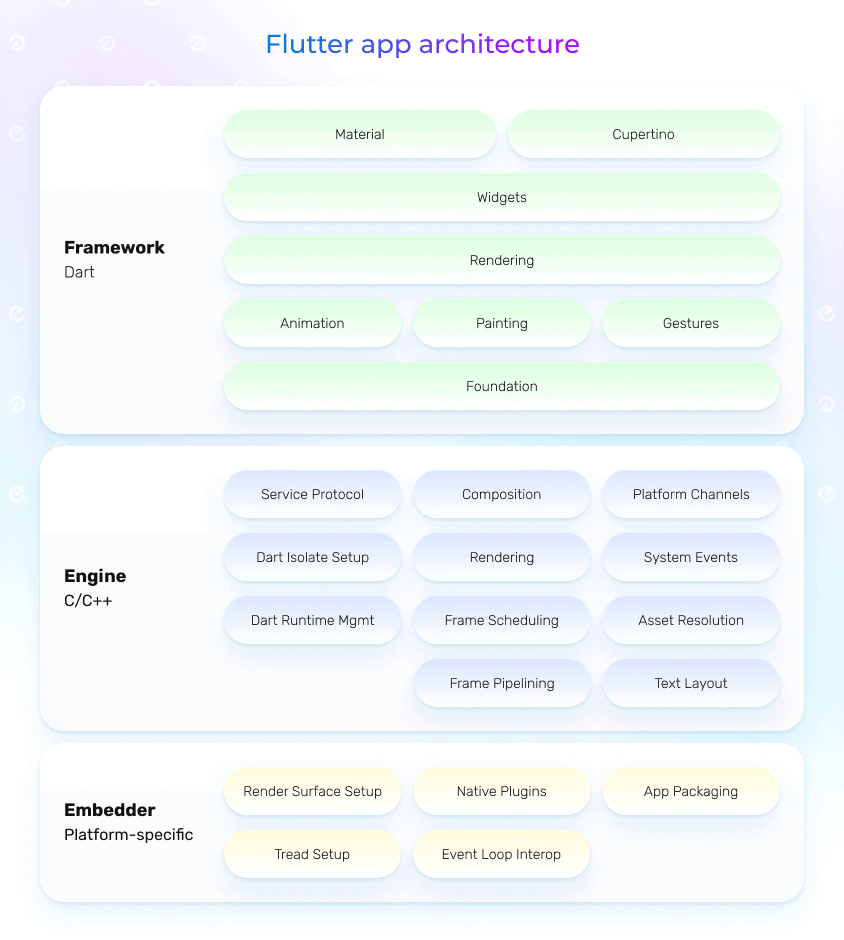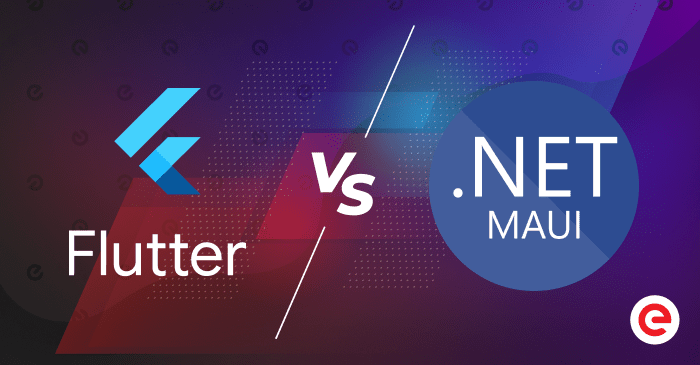
Updated: July 4, 2024
Published: March 2, 2023
Cross-platform development is more critical now than ever, with customers expecting the tools they use to work across various devices. Whereas development teams need to focus on finding the best technology to implement such solutions. In this article, we will focus on .NET MAUI vs Flutter comparison and see how fast the technology evolution takes place.
List of the Content
- .NET MAUI vs Flutter: market trends
- What is .NET MAUI, and how to use it?
- What is Flutter, and why choose it?
- .NET MAUI vs Flutter: technical factors
- Flutter vs .NET MAUI: business factors
- .NET MAUI vs Flutter: what’s better for app development?
- Conclusion
.NET MAUI VS FLUTTER: MARKET TRENDS
It’s always a key point to evaluate best market practices and tendencies to stay ahead of the competition and implement successful products. With the fast-evolving technology advancement, teams have no choice but to use the latest tools to facilitate faster and more efficient software development. Choosing the right technology is a critical decision that can impact the overall success of your project.
All technologies have their strengths and weaknesses, and developers should carefully evaluate their options and choose the one that best meets the project requirements and aligns with the development team’s skills and experience. Taking advantage of cross-platform development, more and more teams leverage this approach into practice. It is explained by such distinct benefits as faster development, easier maintenance, consistent user experience, cost-effectiveness, a broader audience reach, etc.
To start with, it’s worth checking how the interest in one or another technology changes over time. Some technologies manage to evolve fast and support continuing popularity. For others, it requires considerable effort to keep pace. At the same time, there are always representatives that become obsolete, and new representatives take their place.
According to Google Trends, Flutter has considerably gained in popularity and takes the top position among cross-platform technologies. With a growing community of developers and a high level of satisfaction among customers, it has explicit adoption across various projects. Among the main alternatives, we can find React Native and Xamarin; however, we shouldn’t also forget the newly emerging competitors like .NET MAUI.
Want to compare Flutter with React Native or Xamarin?
We suggest checking our latest articles covering a detailed comparison with other known cross-platform technologies.
We’re going to take a look from a different perspective and consider the newest market representatives. Let’s draw the .NET MAUI vs FLutter comparison and learn more about what makes these cross-platform frameworks serious competitors.
WHAT IS .NET MAUI, AND HOW TO USE IT?
To explain what .NET MAUI is, we need to revisit the early days of .NET when it only functioned on Microsoft’s Windows OS. To make it compatible with other operating systems like Linux, they introduced Mono, an open-source .NET framework implementation. Later, Xamarin, a part of Microsoft, replaced Mono and enabled cross-platform development using Xamarin.Forms, which provided native controls for Android, iOS, and Windows.
.NET MAUI is a new Microsoft release based on Xamarin.Forms but with updated and streamlined features that make cross-platform development even easier for developers. It stands for Multi-platform App User Interface and is not just a repackaged version of Xamarin.Forms.
The official release of .NET MAUI was announced on May 23, 2022, following several preview builds. It will follow the same monthly service schedule as other .NET releases and maintain an 18-month release schedule. Microsoft also plans to incorporate plugins, libraries, and services from the .NET framework and update the old project system to make it compatible with .NET 6.
Microsoft has declared .NET MAUI as the Xamarin successor, and all Xamarin projects must be migrated to .NET MAUI by May 1, 2024. Currently, teams can continue to use Xamarin without any problems, but it is strongly recommended that they transition to .NET 6 or later. The announced term ensures support for Xamarin SDKs with the final version of iOS 16 and Android 13.
With .NET MAUI, you can use a single API to write an app that can run on Android, iOS, macOS, and Windows platforms. This unified API offers developers the convenience of writing code only once while still providing deep access to all aspects of each platform. In contrast, when using the platform-specific frameworks provided by .NET 6 or greater, you need to create a separate code-base for each platform to design the user interface and specify how its elements communicate and interoperate.
The .NET Base Class Library (BCL) underlies all the platform-specific frameworks, abstracting away the underlying platform details from your code. This library relies on the .NET runtime to execute your code, which is implemented by Mono on Android, iOS, and macOS, and by .NET CoreCLR on Windows. .NET MAUI simplifies cross-platform app development by providing a single framework for building the user interface.
As for the main benefits of using .NET MAUI, it includes:
Cross-platform development: With .NET MAUI, they can write code once and deploy it to multiple platforms, including iOS, Android, Windows, macOS, and Linux. This can save development time and resources, as well as simplify the maintenance of the app.
Native UI: .NET MAUI provides native user interfaces and controls for each platform, which can help create high-quality, consistent user experiences across all devices.
Open-source and community-driven: .NET MAUI is an open-source project with an active community of developers contributing to it, which means that it is constantly evolving and improving.
Integration with .NET ecosystem: This framework is built on top of the .NET ecosystem, which provides a vast set of tools, libraries, and frameworks that can be used to develop, test, and deploy applications.
Performance: .NET MAUI is designed to be performant, with optimizations such as ahead-of-time compilation, startup tracing, and native linking that can improve app performance and reduce startup times.
Overall, .NET MAUI can help developers build cross-platform apps that are easy to maintain, provide a high-quality user experience, and leverage the benefits of the .NET ecosystem.
WHAT IS FLUTTER, AND HOW TO CHOOSE IT?
Flutter is a prime example of the importance of supporting and advancing technology. In 2015, Google introduced Flutter, a technology primarily designed for Android app development. The main objective was to create a solution that could support both Android and iOS app development. The team released the first stable version of Flutter with iOS and Android support at the end of 2018 and continued to invest heavily in advancing the framework. Flutter quickly gained popularity among developers and has been adopted in a variety of projects, with over 500k applications built with Flutter at present.
Flutter’s advancements have gone even further with the introduction of support for web, desktop, and embedded platforms. This has made Flutter one of the most rapidly evolving cross-platform solutions available. The framework is open-source and easily accessible to the community, with the best practices adopted to make it more convenient for developers. Flutter can be used for mobile, web, desktop, and embedded app development, offering the benefits of cross-platform development approaches.
Developers appreciate Flutter’s excellent functionality, fast development, high performance, accessible documentation, and strong community support. Additionally, the introduced system architecture differentiates Flutter with an extensible and layered system that allows working with independent libraries. Framework layers are replaceable and optional, allowing developers to work with the underlining layers as needed.
Flutter uses the powerful language, Dart, to handle the same UI and business logic for any platform. Converting Dart code into native code is easy for the required platforms, including web, mobile, or desktop. Working with a single codebase increases productivity and streamlines the workflow. Furthermore, developers are provided with many useful tools for testing, debugging, performance, and other tasks.
Flutter has gained significant support in the market, with projects of different complexities and various specifications adopting it. Flutter is efficient for delivering beautiful and functional apps, making it an excellent choice for both large businesses and small teams. The framework contains everything needed to support productive workflows and build reasonable solutions. Flutter continues to expand, with tremendous potential for development teams and businesses. Flutter has achieved considerable success and has become a strong competitor to more mature technologies like React Native.
Flutter’s popularity is also supported by the next reasons:
Fast development: Flutter provides a fast development cycle with its Hot Reload feature, which enables developers to instantly see the changes made in the code. This makes it easier and faster to iterate on designs, fix bugs and add features.
Cross-platform development: Flutter helps developers to create apps for Android, iOS, and other platforms with a single codebase. This saves time and reduces the cost of development.
Native-like performance: Flutter provides native-like performance due to its use of a high-performance rendering engine and its ability to compile code directly into native machine code. This allows for a smooth and responsive user experience.
Rich set of widgets: Flutter provides a rich set of customizable widgets that are designed according to the Material Design and Cupertino design language. This allows developers to create beautiful and functional user interfaces quickly and easily.
Open-source and supportive community: Flutter is an open-source solution, which means that developers can access the source code and contribute to its development. There is also a large and supportive community of developers who share their experiences and knowledge on forums, blogs, and social media, making it easier for new developers to learn and build with Flutter.
Overall, the combination of fast development, cross-platform compatibility, native-like performance, a rich set of widgets, and a supportive community has made Flutter an increasingly popular choice for building mobile applications.
How do businesses use Flutter to their advantage?
Take a look at the article about popular Flutter app examples and how this technology can cover technical and business needs across various use cases.
.NET MAUI VS FLUTTER: TECHNICAL FACTORS
When selecting a tech stack, it’s crucial to evaluate its current functionality and potential for future development. The technology market is rapidly evolving, and even some great technologies may lose their standing if they don’t continually evolve.
One of the biggest advantages of both .NET MAUI and Flutter is their ability to build cross-platform applications with a single codebase. That means developers can write code once and deploy it to multiple platforms, saving resources and time. Both frameworks have their own advantages and disadvantages when it comes to cross-platform development. However, the way each framework achieves this is different and makes it a strong competitor in the .NET MAUI vs Flutter choice.
.NET MAUI vs Flutter: language comparison
The most significant difference between Flutter and .NET MAUI is the programming language used. Flutter uses Dart, a language developed by Google. It has a relatively small learning curve and is easy to understand for developers familiar with Java or JavaScript. The language’s syntax is clean, concise, and easy to read, making it an excellent choice for developing mobile applications.
.NET MAUI, on the other hand, uses C# as its primary language. C# is a popular language for developing Windows applications and is widely used in the enterprise world. It has a more complex syntax than Dart and has a steeper learning curve. However, C# is a mature language with excellent support for object-oriented programming, making it a great choice for large-scale projects.
.NET MAUI uses a single project and a single codebase to build apps for multiple platforms. This means developers can write code in C# and XAML and use a single API to access platform-specific features. In contrast, Flutter uses a single language, Dart, and a single codebase but has a unique rendering engine that allows for high-performance UI across platforms.
UI development with .NET MAUI vs Flutter
UI development is an essential part of cross-platform app development, and both .NET MAUI and Flutter provide tools and features to help developers create beautiful and responsive UIs.
.NET MAUI provides a range of UI controls and layouts that can be used to build complex and customizable UIs. It also supports native theming and styles, making creating a consistent look and feel easier across platforms. In addition, .NET MAUI supports hot reload, which allows developers to check the changes they make in the UI in real time, saving time and effort.
On the other hand, Flutter provides a highly customizable and performant UI framework with a wide range of customizable UI widgets and animations. Flutter’s unique rendering engine allows for smooth and performant animations, making it ideal for building highly interactive UIs. Flutter also supports hot reload, making it easier to iterate on the UI and see changes in real-time.
.NET MAUI vs Flutter: cross-platform capabilities
Both Flutter and .NET MAUI are designed to create cross-platform applications by writing code once and deploying it on multiple platforms. This approach saves development time and reduces costs for companies. Flutter and .NET MAUI achieve cross-platform capabilities through different approaches.
Flutter uses a single codebase to create Android, iOS, web, and desktop applications. It achieves this through a “write once, run anywhere” approach, where the same codebase can be used for all platforms. This approach makes maintaining and updating the application easy since all changes are reflected across all platforms.
.NET MAUI takes a slightly different approach to cross-platform development. It uses a unified API to create applications for iOS, Android, macOS, and Windows. However, it has a different implementation for each platform, which allows it to take advantage of the native capabilities of each operating system. This approach ensures that the application runs smoothly on each platform and has a native look and feel.
Performance with .NET MAUI vs Flutter
Performance is a critical factor when it comes to cross-platform app development. In the light of the .NET MAUI vs Flutter, they have their own ways of ensuring high performance.
.NET MAUI leverages the power of native UI controls and features to provide fast and responsive UI performance. It also supports Ahead of Time (AOT) compilation, improving app startup time and reducing memory usage. In addition, .NET MAUI supports lazy loading of controls, which can improve performance by loading only the controls that are needed at runtime.
Flutter uses its own rendering engine and provides fast and smooth UI performance. Flutter’s rendering engine supports hardware-accelerated graphics and provides highly performant animations and transitions. In addition, Flutter supports Just In Time (JIT) compilation, which can improve development speed, and Ahead of Time (AOT) compilation, which can improve app startup time and reduce memory usage.
.NET MAUI vs Flutter ecosystem
The ecosystem is another important factor to consider when choosing a framework for app development. The ecosystem includes the tools and libraries that are available to help developers build, test, and deploy their apps.
.NET MAUI has a strong ecosystem of tools and libraries, including Visual Studio, Visual Studio Code, and Xamarin.Forms. In addition, .NET MAUI provides integration with Azure services, making it easier to build and deploy cloud-based apps.
Flutter also has a strong ecosystem of tools and libraries, including the Flutter SDK, Android Studio, and IntelliJ IDEA. In addition, Flutter provides integration with Firebase, which provides a wide range of tools and services for building and deploying mobile apps.
.NET MAUI VS FLUTTER: BUSINESS FACTORS
The choice between .NET MAUI and Flutter ultimately depends on your specific needs and preferences. Both frameworks have their own advantages and disadvantages, and the decision should be based on factors such as business aspects.
Market popularity
When it comes to market popularity, Flutter seems to be winning. According to Google Trends, Flutter is more popular than .NET MAUI in terms of search interest. Flutter has gained a lot of popularity in recent years, with many businesses choosing it as their preferred cross-platform development framework. One of the reasons why Flutter is so popular is that it offers a great user experience and a fast development process. Additionally, it has a large and growing community of developers, which makes it easy to find resources and support. The number of stars on GitHub reaches more than 150k.
.NET MAUI, on the other hand, is a relatively new framework. It is an evolution of Xamarin.Forms, and it was released in May 2023. As such, it has not gained as much popularity as Flutter yet. However, it is important to note that .NET MAUI is backed by Microsoft, which is a major player in the tech industry. That gives it an advantage in terms of market penetration, as Microsoft can leverage its existing customer base to promote .NET MAUI. It is gaining its popularity fast, with 18.3k GitHub stars compared to Flutter, which has been much longer on the market.
Development process
The development process is another important consideration when choosing a cross-platform development framework. Businesses need a framework that allows for fast and efficient development with minimal coding errors and bugs. If we compare Flutter vs .NET MAUI, they offer a great development experience with unique features that cater to different needs.
Thanks to its hot-reload feature, Flutter is known for its fast development process. This feature allows developers to see the results of their code changes instantly without restarting the app. Additionally, Flutter has a large library of pre-built widgets, which makes it easy to build user interfaces quickly and efficiently.
.NET MAUI also offers a fast and efficient development process, with features like hot-reload and live visual tree updates. Additionally, .NET MAUI has a new markup language called XAML Hot Reload, which makes it easy to create user interfaces using a declarative syntax. This can make the development process faster and more efficient for developers who are used to working with XAML.
Continuing with .NET MAUI vs Flutter comparison, they aim to simplify application development for developers. However, since .NET MAUI is a new framework, the development experience is still evolving, and some features may not be as polished as they are in Flutter.
Technology stability
Technology stability is an important consideration when looking for a cross-platform framework. Businesses need a stable and reliable framework that can become a solid choice. Comparing Flutter vs .NET MAUI, Flutter has gained a stronger position here.
Flutter is a mature framework that has been around since 2018. It has a stable codebase with a robust set of features and libraries. Flutter is also known for its hot-reload feature, which allows developers to make changes to their code and see the results instantly. That makes the development process faster and more efficient.
.NET MAUI, on the other hand, is still in its early stages. However, it is built on top of Xamarin.Forms, which is a stable and reliable platform. This means that .NET MAUI inherits all the stability and reliability of Xamarin.Forms, while also adding new features and improvements. Additionally, Microsoft has a track record of creating stable and reliable technologies, which bodes well for the stability of .NET MAUI.
Cost-efficiency
Businesses need to choose a framework that is cost-effective and offers a good return on investment. When it comes to cost efficiency, both .NET MAUI and Flutter are competitive options.
Flutter is an open-source framework, which means that it is free to use and comes with no licensing fees. This makes it an attractive option for businesses that are looking for a cost-effective solution. Additionally, Flutter offers a fast development process, which can save businesses time and money in the long run.
.NET MAUI is also free and open-source, with no licensing fees. However, it is important to note that businesses may need to pay for additional services and tools, such as Azure DevOps or Visual Studio Enterprise, which can add to the cost. Additionally, .NET MAUI is a new framework, which means that there may be a learning curve for developers who are not familiar with Xamarin.Forms.
Community support
A large and active community can provide developers with resources, support, and a sense of community. In the light of comparing .NET MAUI vs Flutter, they have active and growing communities with resources and support available for developers.
Flutter has a large and active community of developers, with many resources available online. There are many online communities and forums, such as the Flutter Meetup Network, Flutter Discord, the Flutteristas, and others. It supports building a diverse and welcoming community as developers can ask questions, share resources, and get support.
.NET MAUI is also focused on building an active community. Even though it is a new market player, it can rely on the .NET community, which is large and active, with many resources available on the Microsoft website and other online communities. Additionally, .NET MAUI inherits all the resources and support from Xamarin.Forms, which have an active community of developers and resources available online.
.NET MAUI VS FLUTTER: WHAT’S BETTER FOR APP DEVELOPMENT?
The .NET MAUI vs Flutter choice ultimately depends on your specific needs and preferences. Both frameworks have their own advantages and disadvantages, and the decision should be based on factors such as your development team’s expertise, the platforms you are targeting, and your development requirements.
| .NET MAUI | Flutter | |
| Type | Open-source framework | Open-source framework |
| Stable release | 2022 | 2018 |
| Programming language | C# | Dart |
| Performance | High | High |
| Cross-platform capabilities | iOS, Android, macOS and Windows, Blazor and Tizen support | Mobile, web, desktop and embedded support |
| UI components | Native UI components | Built-in customized UI components |
| Technology stability | Evolving technology | Mature technology |
| Developers’ availability | Smaller but growing community | Huge and supportive community |
| Supported by | Microsoft | |
| Future perspectives | The promising market competitor | Continuously and fast-evolving technology |
If you are looking for a highly customizable and performant UI framework, Flutter may be a better choice for you. Flutter’s unique rendering engine provides smooth and performant animations, making it ideal for building highly interactive UIs. In addition, if you are targeting multi-platform support, including iOS and Android, Flutter may be a better choice, as it has strong support from Google and a large and growing community of developers.
If you are already familiar with C# and .NET, .NET MAUI could be a good choice for you, as it allows you to leverage your existing skills and expertise. In addition, this technology becomes the primary choice for Xamarin apps due to the required transition through May 2024. However, at least in its current state, the technology is actively developing and has some limitations. As long as the team is aware of this, they will be able to undergo the transition stage and stabilize the environment in the near future.
It might seem a challenging task to choose at first. Though drawing a detailed .NET MAUI vs Flutter comparison and defining your project needs always helps to make the right decision.
CONCLUSION
Both frameworks are excellent choices for building cross-platform mobile applications. The .NET MAUI vs Flutter choice depends on the specific needs and preferences of the project and development team. It’s recommended to evaluate each framework’s strengths and weaknesses in the context of your project and choose the best one to fit your needs.
If you start creating a cross-platform app from scratch, we would recommend using Flutter. It stands out as it is a well-established environment that has undergone consistent enhancements. Furthermore, Flutter has remained steady throughout its evolution and proved its efficiency and flexibility. Obviously, .NET MAUI could be considered in the future, as it has all the capabilities to achieve technical equivalence with its primary competitors.
How to find a professional team to start cross-platform development?
Feel free to contact Existek. We are a software development company with first-hand experience in creating cross-platform solutions. We know how to address your needs by leveraging the best market practices and solutions.
Frequently asked questions
What are the most popular cross-platform technologies?
Top frameworks for creating cross-platform applications include:
Flutter
React Native
Xamarin
.NET MAUI
Will .NET MAUI replace Xamarin?
Yes, .NET MAUI presents a complete overhaul of Xamarin. As well as, every Xamarin project has to undergo the transition to .NET MAUI through May 1, 2024.
What is the main difference between .NET MAUI and Flutter?
The key difference between these frameworks is the programming language. .NET MAUI uses C#, while Flutter uses Dart. C# is a statically typed language and has been around for much longer than Dart. However, Dart has a cleaner syntax and is easier to learn.
.NET MAUI vs Flutter: what’s better?
Both .NET MAUI and Flutter are excellent choices for building cross-platform applications. The choice between the two depends on the specific needs and preferences of the project and development team. At the same time, Flutter is a more mature technology with flexible and efficient solutions for cross-platform development. For now, it makes it a better choice compared to .NET MAUI, which is just at the beginning of its timeline.

